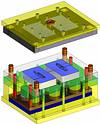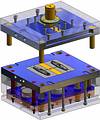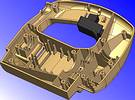RIP technology for Smallworld software suite
1 February 2004
Product development imperatives
Many factors determine the success or failure of an engineering company but the quality of the product, the extent to which it is superior to the competitions', and the speed with which it is brought to market are paramount. To compete successfully in today's economic and industrial climate engineering companies need to deliver continually improved products at a speed and cost determined largely by the market. Whilst product quality, performance and price are of major importance, speed into the market is essential in order to stay ahead of the competition. Yet speed is the natural enemy of quality, and cutting down on costs can be taken only so far before everything else is adversely affected. Somehow, an optimum engineering solution to incompatible objectives has to be found.
Product design and development is a process of trial and error to reach an optimum balance between product 'perfection' and time to market. Time, as always, is the enemy. Time pressures normally mean that design has to start before all the necessary information is to hand. Teamwork, bringing in production people and suppliers at an early stage, saves time and helps to ensure that initial design concepts are valid. Mechanical, electrical and electronic design must be carried out in parallel. Everything has to be made to fit and work together. Engineering analysis leads to design modifications that optimise weight, minimise material, avoid dynamic problems and simulates systems. Manufacturing considerations may change initial design ideas. Customer specifications or market conditions may change in midstream. The product development manager has to control the whole of this dynamic process and still deliver on time.
Back in 1988 McKinsey & Partners showed how much company profit can be lost as the result of loss in market share due to late delivery of a new product, highlighting the crucial importance of 'time to market'. (See Table 1.) Changes that take place late in the design/production cycle can be disastrous, though changes made in the early stages of design might represent desirable design improvements and innovation. Concurrent and collaborative engineering were the organisational responses to these challenges, based on a foundation of 3D digital product modelling.

3D CAD and the product development process
Nowadays the product development manager must look way beyond questions of drawing productivity when deciding on the right CAD tools to specify. 2D CAD technology has delivered all the drawing productivity improvements we are likely to get and those benefits have long ago been absorbed. 3D CAD, on the other hand, is a completely different technology, capable of delivering far more wide-ranging benefits across the whole of the engineering and collaborative engineering process. Whereas 2D CAD shortens time scales to some extent, 3D CAD goes much further, directly supporting the whole product development cycle, speeding up every activity and increasing the quality of design by removing many sources of inaccuracy and error. The accurate 3D solid geometric model, together with all the non-geometric engineering information attached to it, becomes a complete 'digital product model' for purposes of design review, holding all the information required to analyse, procure and make it, in a form immediately usable by all engineering processes. When allied to product data management and the Internet, 3D solid modelling provides an entire foundation for product information flow across the collaborative engineering network.
A 2D drawing is an indirect and incomplete representation of an engineering product or system, subject to interpretation and error. Taking off data in correct form for downstream analysis, simulation and manufacturing processes requires additional effort and is subject to mistakes. Sending drawings electronically to partners, customers and suppliers is fine, but the potential for errors and misinterpretation remain. By contrast, 3D solid modelling produces a complete and accurate geometric model of the product, analogous to a physical model. Any required geometric and physical information can be derived from it for purposes of engineering analysis, simulation and manufacture, using linked specialist applications that have become an integral part of the concurrent engineering process. Given this high degree of integration it becomes feasible to iterate through several cycles of design, analysis and manufacturing simulation at an early stage in design in order to encourage innovation while achieving the best possible product within the time available. Product and engineering data management, similarly integrated, ensures that the engineering product is fully and accurately documented by the time the design is complete.
For those people not yet using 3D CAD it is important to review the available technology regularly. Only a few years ago, for instance, solid modelling was limited to components and small assemblies by restrictions in desktop computer power, data storage and software design. Today's mainstream Windows-based 3D solid modelling systems can handle large assemblies, hold all the relationships between features, components and assemblies, and generate 'on the fly' all the non-geometric product data required for engineering data management. Examples across a range of industry sectors show that a modern Windows-based 3D solid modelling system with hybrid 2D/3D technology is capable of delivering results such as:
* Product development time reduced by up to a factor of five.
* Engineering change orders reduced by 50% to 90%.
* A doubling of design productivity, including drawing productivity.
* Elimination or major reduction in physical models or prototypes.
* Increase in product innovation and quality through greater potential for engineering analysis.
* Virtual elimination of design related tooling and manufacturing errors.
* Engineering change orders reduced by 50% to 90%.
* A doubling of design productivity, including drawing productivity.
* Elimination or major reduction in physical models or prototypes.
* Increase in product innovation and quality through greater potential for engineering analysis.
* Virtual elimination of design related tooling and manufacturing errors.
In our view, 3D solid modelling technology has now come of age and should be seriously investigated by any product development manager who faces the kind of challenges we have described. Not everyone will achieve top of the range results in every area, but there is now ample evidence that '3D' can typically cut product development times in half.

Implementing 3D CAD
Observing that there are still some concerns about the possible difficulty and cost of implementing 3D CAD we have analysed them with a view to deciding how real they are, and whether they are based on insufficient understanding of the technology. The major advantages of 3D technology are generally understood though possibly not fully appreciated until seen in practice. Implementing any new technology inevitably carries some risk. Concerns appear to be of three main kinds.

"It will cost too much"
System costs for mainstream Windows-based 3D CAD have decreased substantially in recent years while, at the same time, systems capability has increased, so it is important to check out the situation regularly. We would suggest, however, that system cost is not the primary issue. In all the companies we speak to, the investment has been made in order to protect their business, sometimes as a matter of immediate survival, more often as a planned strategy to increase product competitiveness and get their products to market faster. 3D CAD is seen in these companies as impacting both sales and costs: sales as a result of better product engineering; and costs as a result of shorter product development cycles and less waste of time and material. It has been said to us many times, "The real issue is the cost of not doing it."

"My engineers do not think in 3D"
Surely this is not true [the author speaks as an engineer]. We live in a 3D world and would not survive without an innate ability to navigate in it. People had to work with 2D drawings before CAD was invented and that created a certain mindset. The first CAD systems were for 2D drawing, with crude 3D wire-line facilities, included because designers needed at least to create perspective drawings for visualisation and purposes. Much time was wasted on physical modelling and prototype building activities that are wholly or mainly eliminated by the use of 3D CAD. In our experience designers and engineers generally feel a huge sense of empowerment when presented with a 3D CAD modelling system, because it is the natural way to think and work.
A related concern is that people will find 'driving' a 3D modelling system difficult. In our opinion, neither of these concerns is real, given a modern 3D CAD system with a well designed user interface and a structure that feels logical to a design engineer. With several hundred thousand design engineers out there successfully using 3D CAD solid modelling, it hardly seems feasible that all those who are not doing so are incapable. Anyone considering 3D investment for the first time, however, should always say 'show me'. It is important, at the earliest opportunity, to see 3D in action and if possible to get some hands-on experience in order to prove the point. This should dispel doubts about most people's ability to drive these systems and will certainly show the speed with which a full three dimensional solid digital model of the product is generated.
"I will not be able to get my present job done"
This thought reveals a basic misconception, namely that adopting 3D means dropping 2D. Modern mainstream 3D CAD modelling systems are in fact hybrid 2D/3D systems, integrating 2D drawing and 3D modelling within the one system, so enabling the user to work in drawing mode or solid modelling mode interchangeably. In practice, 2D drawing continues to be essential for various reasons:
* Drawing on planes or surfaces is a standard way of creating 3D solid models.
* Legacy 2D drawings are likely to form the basis of at least parts of new products and need either to be re-used or imported into the 3D system to help create solid models.
* Complex assembly layouts are often best worked out initially in drawing mode.
* In a collaborative engineering environment it may still be necessary or desirable to send 2D drawings to design partners, suppliers and contractors.
* Legacy 2D drawings are likely to form the basis of at least parts of new products and need either to be re-used or imported into the 3D system to help create solid models.
* Complex assembly layouts are often best worked out initially in drawing mode.
* In a collaborative engineering environment it may still be necessary or desirable to send 2D drawings to design partners, suppliers and contractors.
Hybrid 2D/3D technology is a powerful development that removes the inherent problems of making a step change from 2D to 3D working, and provides the means for the user organisation to evolve in a controlled manner from 2D CAD to an optimum mix of 3D modelling and 2D drawing. The product development manager can largely avoid disruption by introducing 3D modelling methods progressively, step-by-step, according to the opportunities presented by the job in hand, the needs of collaborative engineering partners and the varying aptitude of system users.
Typical steps in a controlled transition
In our experience most companies find their engineers have little difficulty in adapting to 3D working. In any case, hybrid 2D/3D technology with fully integrated 2D drafting enables management to take a step-by-step approach to the transition. Typical steps would be:
* Become familiar with the new user interface while continuing to work in 2D mode.
* Get some practice in producing 3D component models from existing 2D drawings.
* Develop skills in assembly modelling, iterating between assembly sketches and solid models, exploring interference and motion simulation.
* Progress to 'full 3D' design mode, utilising the full range of modelling and data management facilities within the product.
* Develop interfaces to 'downstream' engineering analysis, manufacturing, engineering data management and ERP systems, as appropriate.
* Get some practice in producing 3D component models from existing 2D drawings.
* Develop skills in assembly modelling, iterating between assembly sketches and solid models, exploring interference and motion simulation.
* Progress to 'full 3D' design mode, utilising the full range of modelling and data management facilities within the product.
* Develop interfaces to 'downstream' engineering analysis, manufacturing, engineering data management and ERP systems, as appropriate.
This approach will make transition easier for all concerned, and is likely to be completed quite quickly.
Conclusions
Evidence from many engineering companies, and our own technology research, consistently provides confirmation that Windows-based 3D solid modelling CAD systems, with integrated product data management, are now more than capable of delivering greatly increased overall engineering effectiveness and major reductions in product development time scales - typically by half or more.
Modern 3D CAD products have successfully addressed concerns related to the time, cost and learning curve related to the introduction of this technology. For example, we have noted how disruption of current product development work can be substantially avoided by exploiting hybrid 2D/3D technology to permit progressive evolution from 2D working to fully integrated 2D drawing and 3D solid modelling.
For more information on the effective implementation of 3D CAD solutions, contact EDS PLM Solutions' local representative ESTEQ Design, 012 991 9211, c.oosthuizen@esteq.com, www.esteq.com
Digital assembly
A supplier of machinery to the canning industry found that the use of 3D solid modelling allowed them to design a new machine in half the time it would have taken using 2D CAD. The ability to 'digitally assemble' the machine, which automatically bags can lids and places them on a pallet, ensured that all 4000 components interacted perfectly when the first prototype was built. Being spared the lengthy process of finding and fixing problems in a physical prototype accounted for most of the 12-month timesaving on the project.
Easy to learn
One of the world's leading manufacturers of printers and copiers moved to 3D solid modelling several years ago, choosing a system that would enable them to make the transition efficiently across a large engineering organisation. So far they have successfully trained more than 250 engineers to work with the system.
Import 2D
When evaluating 3D CAD systems prior to purchase, an international supplier of high efficiency water heaters and boilers looked specifically at how well each system would ease the transition from an old 2D system into 3D. In order to maintain product development momentum it needed to import legacy 2D product data to the new system and avoid having to re-create existing parts and assemblies from the old system. This turned out to be one of the main factors determining its choice of system.
Cambashi ( www.cambashi.com) researches the use of information and cmmunication technology (ICT). The company's goal is to understand:
* The business reasons that drive ICT investment decisions.
* The technology that addresses these issues.
* The market mechanisms that bring users and vendors together.
* The impact of deployment of applications and infrastructure.
* The technology that addresses these issues.
* The market mechanisms that bring users and vendors together.
* The impact of deployment of applications and infrastructure.
Cambashi's work in the manufacturing industry sector has grown from a focus on design engineering to include industrial automation and business systems. The ideas and opinions expressed in this white paper are Cambashi's own, based on its continuous programme of independent research and monitoring of the industry sector. Cambashi wishes to thank EDS PLM Solutions for sponsorship of production of this document.
Others who read this also read these articles
EDM - who needs it?
An EDMS is basically a computer database system designed for keeping track of documents, changes to them, related documents, and possibly to control the access to documents and assist or even enforce established procedures for workflow or QA[ December 2005 ]
Spatial document management
ProjectWise is the most popular technical document and AEC content management tool in SA and adding a spatial component opens up a whole new dimension[ August 2004 ]
What is up, docs?
DvTDM, the Total Document Manager developed by Practical Programs, and is available from Kinetic Distribution, can actually be configured to force documents to be stored within the system[ August 2004 ]
The CAD File is the business
CAD files form the technical foundation from which industrial businesses and plants are run[ August 2003 ]
The high cost of information erosion
Intergraph Process, Power & Offshore has developed integrated solutions and products to assure data accuracy and consistency, and enable the efficient creation, management and use of plant engineering information throughout the plant lifecycle[ June 2003 ]
Powerful document management solution
DataViewer X is an advanced Document and Drawing Management solution that can interface with leading CAD products to produce advanced technical and product document solutions[ February 2003 ]
Digital signatures resolve electronic catch-22
The much-touted 'paperless' work environment has finally become a reality[ December 2002 ]
MicroStation V8 is e-ready for digital signatures
Recent acknowledgment of digital IDs, certificates, and signatures offers new opportunities to streamline workflows and strengthen the protection of one's digital intellectual property[ October 2002 ]
Others who read this also read these news items
A solution to CAD data management problems
[ October 2005 ]
Engineer your drawing management
[ August 2005 ]
The paperless age
[ June 2005 ]
Effectively handle document processes
[ April 2004 ]
Flexible solution for digitising drawings
[ February 2004 ]
Dataviewer X gets new name and enhancements
[ February 2004 ]
World's largest export coal terminal discovers SAP DMS
[ February 2004 ]
New software to index and archive scanned drawings
[ February 2004 ]
Others who read this also read these regulars
Search Site
Subscribe
Previous Issues
Other Technews Publications
Other Technews Buyers Guides
 |  | Copyright c1995-2009 Technews Publishing (Pty) Ltd.. All rights reserved. |